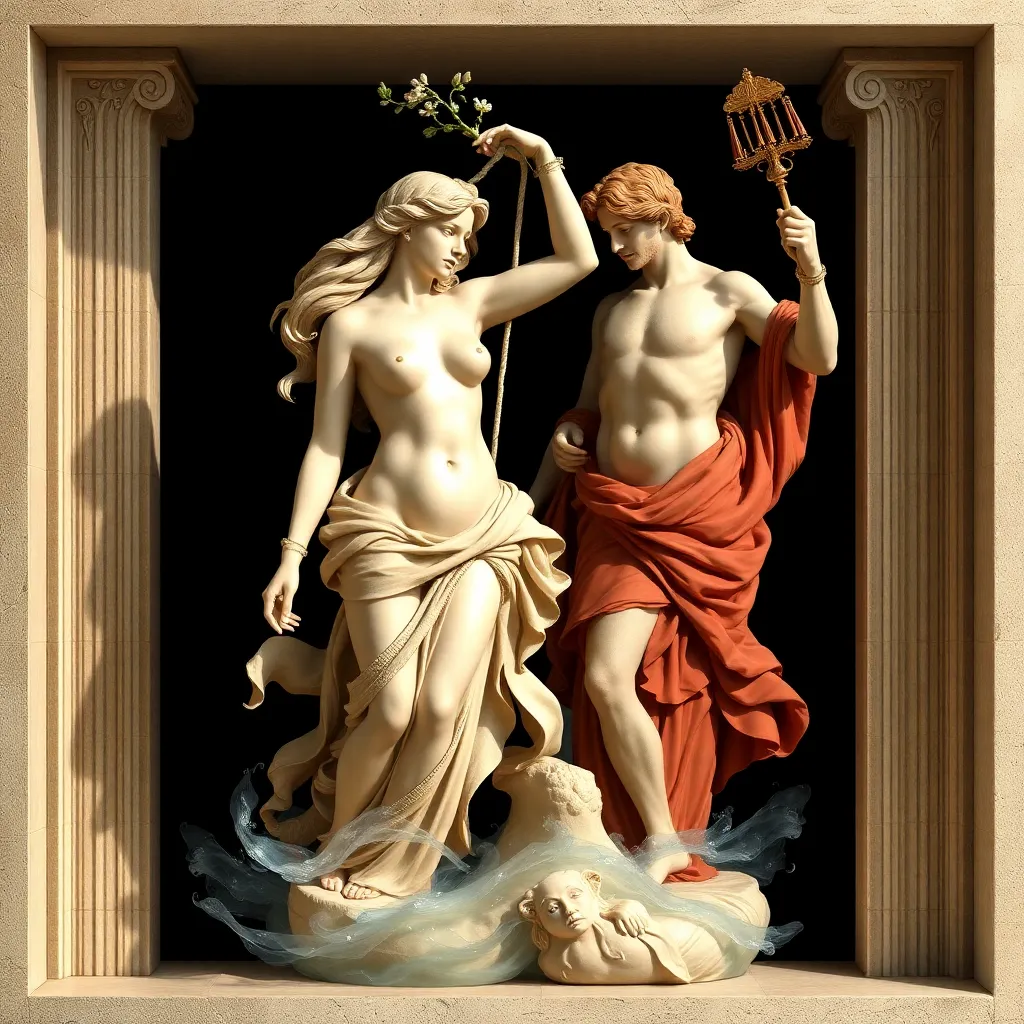The Myth of Aphrodite and Adonis: Love, Loss, and Transformation
I. Introduction
The myth of Aphrodite and Adonis stands as one of the most poignant tales in Greek mythology, encapsulating the themes of love, loss, and transformation. Aphrodite, the goddess of love and beauty, and Adonis, a mortal of extraordinary beauty, share a love that transcends the ordinary, yet is fraught with tragedy. Their story illustrates not only the depth of their passion but also the inevitable sorrow that accompanies love. This article aims to explore the origins of their relationship, the nature of their love, the profound loss that follows, and the transformations that ensue, all while reflecting on the myth’s ongoing relevance in contemporary culture.
II. The Origins of Aphrodite and Adonis
Aphrodite, one of the twelve Olympian gods, represents love, beauty, pleasure, and procreation. Her allure and charm affected gods and mortals alike, making her a central figure in many myths. Adonis, on the other hand, was born from an unusual union; his mother was Myrrha, who was transformed into a myrrh tree after a tragic affair with her father. From this tree, Adonis emerged, a symbol of beauty and desire.
Their meeting was orchestrated by fate. Aphrodite, captivated by Adonis’s beauty, took him under her wing. She entrusted him to Persephone, the queen of the Underworld, who also fell in love with the young man. This rivalry between the two powerful figures set the stage for the unfolding drama of their relationship.
III. The Nature of Their Love
The love between Aphrodite and Adonis is characterized by intense passion and longing. Aphrodite adored Adonis, and their relationship was filled with both joy and heartache. The dynamics of their love illustrate a complex interplay of desire and the fear of loss, which is a recurrent theme in Greek mythology.
- Passionate Romance: Their love was not just physical; it was deeply emotional, showcasing the blend of beauty and longing.
- Symbolism in Art: Artists throughout history have depicted their relationship, often symbolizing the duality of love—its ecstasy and its pain.
- Literary Representations: Poets like Ovid and later Renaissance writers explored their love, emphasizing its tragic elements.
IV. The Theme of Loss
The tragedy of Adonis’s fate is one of the most heartbreaking aspects of their story. He met his end while hunting, mortally wounded by a wild boar, often interpreted as a manifestation of Ares, the god of war, who was jealous of their relationship. This event plunged Aphrodite into profound sorrow.
Aphrodite’s emotional turmoil is vividly depicted in various accounts of the myth. Her lamentation for Adonis reflects the universal pain of losing a loved one, capturing the essence of grief that resonates across cultures.
- Impact on Aphrodite: Adonis’s death left her heartbroken, showcasing the vulnerability even a goddess can feel.
- Cultural Interpretations: The myth serves as a reminder of the fleeting nature of love and life, a theme prevalent in ancient Greek culture.
V. Transformation and Resurrection
One of the most compelling aspects of the myth is the cyclical nature of life and death it conveys. After Adonis’s death, Aphrodite’s tears mingled with his blood, giving rise to the anemone flower—a symbol of rebirth and beauty emerging from tragedy.
Adonis’s eventual rebirth is a significant element of the myth. He is said to return from the Underworld each spring, bringing with him the renewal of life and the blooming of flowers. This cycle reflects broader themes in mythology, such as the connection between life, death, and rebirth.
- Cyclical Life: The myth embodies the idea that endings can lead to new beginnings.
- Broader Themes: Transformation in the face of loss is a recurring motif in mythology, revealing deeper truths about the human experience.
VI. The Influence on Art and Culture
The myth of Aphrodite and Adonis has inspired countless artists throughout history. In ancient times, depictions of the couple often emphasized their beauty and the tragic nature of their love.
- Ancient Art: Sculptures and pottery frequently portrayed scenes from their story, illustrating the tension between love and loss.
- Renaissance Interpretations: Artists like Titian reimagined their love story, exploring its themes of beauty and mortality.
- Literature and Poetry: The narrative has influenced poets and writers, serving as a metaphor for the interplay of love, desire, and sorrow.
VII. Modern Interpretations and Relevance
In contemporary society, the myth of Aphrodite and Adonis continues to resonate. The themes of love, loss, and transformation are timeless, reflecting the complexities of human relationships.
- Contemporary Reflections: The story invites modern audiences to reflect on their own experiences of love and grief.
- Enduring Themes: The cyclical nature of life and the possibility of rebirth are relevant in today’s context, echoing the resilience of the human spirit.
VIII. Conclusion
The myth of Aphrodite and Adonis encapsulates profound themes that resonate through time. It explores the intensity of love, the inevitability of loss, and the potential for transformation. Their story serves as a poignant reminder of the interconnectedness of these experiences in the human condition.
Aphrodite and Adonis’s legacy endures in art and literature, symbolizing the beauty and tragedy of love. As we reflect on their myth, we are reminded of the intricate dance between love, loss, and transformation that defines our shared human experience.




